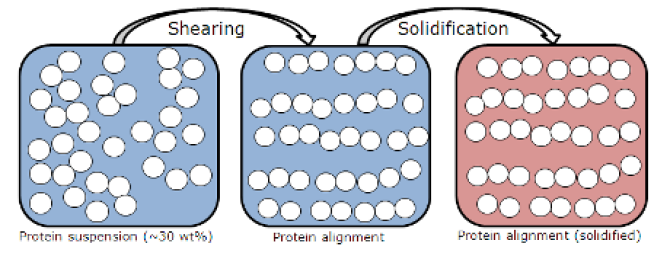Project
Towards Structuring of Protein Domains
BackgroundMeat consists of mainly protein, water and a little bit of fat. As the production of meat is inefficient in use of land, water and raw material there is a question for alternatives. Although the quality of existing meat alternatives is already quite high, new innovations in meat alternatives are needed to convince the real meat-eater. Especially, the juiciness and the fibrous nature of meat are important for a new plant-based product. In addition, plants are not only composed of protein and water, but contain a considerable amount of carbohydrates. Because many meat alternatives are made from soy or wheat flour, they contain large fractions of carbohydrates. These carbohydrates might have an influence on the final properties of the meat alternatives. In this project we therefore want to extract carbohydrates from the plant material. Unfortunately, the production of protein isolates or even concentrates requires large amounts of water and energy for dilution and drying. In addition, the separation of plant material focuses mainly on oil and carbohydrates and not on the isolation of proteins.
Aim
It is important to note that meat has a hierarchical fibrillar structure at different length scales. Recent results have shown that well-defined shear flow in a shearing device can lead to a hierarchical fibrillar enriched dairy protein matrix resembling the structure of meat. In this project, we explore whether the same principle can be applied to enriched plant protein materials. The objective of this study is to develop ‘theoretical’ design rules for the plant protein material that can be used to make anisotropic structures successfully.
Approach
This project will focus initially on the possibilities to structure plant protein on a small length scale (50-350 nm). To do so, small protein molecules have to be aggregated into larger clusters, which might be susceptible for shear flow leading to anisotropic structures. This method requires a relatively pure protein fraction, which will be obtained by a washing and precipitation method. If the purification of protein from plant materials turns out to be too complicated or time-consuming, the use of model proteins such as dairy will be considered. The (plant) proteins will be analysed on their structuring properties under well-defined shear flow and the resulting (anisotropic) product properties will be studied. Here solidification plays an important role.

Figure 1: Protein aggregation, alignment and solidification at high protein concentrations (~30 wt%) under shear flow
After studying the relatively pure protein materials, the influence of non-protein materials, such as carbohydrates and fat, on rheological properties and resulting structures will be studied. Purpose is to determine the effects of their presence during structure formation.
BSc/MSc theses – what to do?
Are you interested in this topic? Then do not hesitate to contact me or drop by to talk about current opportunities for your thesis!
